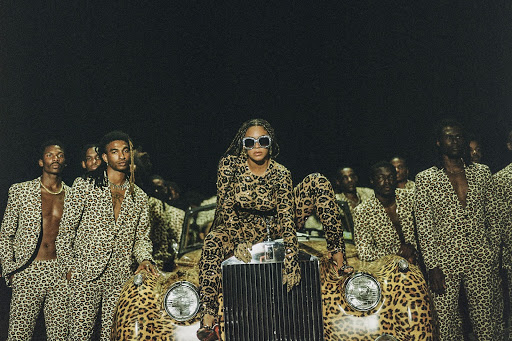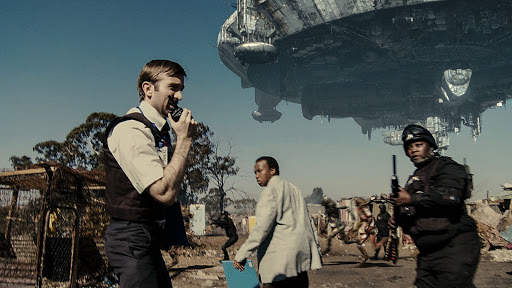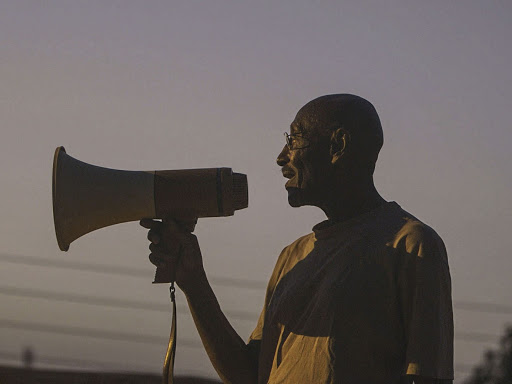Darkest moment: Robert Liensol is the unnamed protagonist in Soleil Ô
The first 12 minutes of Med Hondo’s Soleil Ô (1970) tell the history of imperialism. Through a harrowingly beautiful piece of abstract cinema, the viewer watches as nine men dressed in kanzus relinquish their identities. We watch as they denounce their native tongue, give their lives to the church, ask for forgiveness, and begin again.
As we watch, so does the white man, the overseer, the metaphorical higher power. He watches them train, take up arms, fight among themselves and kill each other. As he watches, so he bribes. With a single banknote, he convinces them to continue the battle and, when only one man is left standing, the overseer hands him the note before sending him west and taking the money back.
The film’s first 12 minutes are a summary of the colonial portion of Africa’s history that so often defines the continent. But our story neither ends nor begins there. Just as this poetic retelling speaks to our darkest moments, the rest of our history has been mapped out and represented, through various lenses, from its beginning. Although it would be possible to divide cinema’s representation of Africa into many different categories, for simplicity’s sake, this piece will look at three: Western, white South African and black African cinema’s representation.
The history of the continent is convoluted, but not impossible to map out. By looking at how, over time, these three groups have portrayed the African continent, one can make a judgment on whether cinema’s timeline of the continent’s development[s] mirrors Africa’s actual one.
 Beyoncé stars in Black is King, a veritable money grab
Beyoncé stars in Black is King, a veritable money grab
Western cinema’s representation of Africa is far from perfect. Hollywood, in the hope of turning a profit, often commodifies African cultures. Disney, in creating Black is King, does not want to show you Africa; it wants to show you Beyoncé in Africa. To the people at Disney, liquidation is a bigger issue than liberation, so they fly the Knowles-Carters to Africa so they can sing about being “part of something bigger” while Disney promotes its live-action remake of The Lion King. That’s not to say that Black is King is terrible. It’s not. It is a celebration of black joy, heritage and history — but it is also disingenuous. There is no meaning to be found in a money grab.
The West’s commodification of African culture does not end there. A general trend in Western narrative films about Africa is that they tend to be based on true stories. Hotel Rwanda speaks to the Rwandan genocide, Mandela: Long Walk to Freedom to apartheid South Africa, and Invictus to the 1995 Rugby World Cup. One would assume that this representation, being simultaneously informative and entertaining, is a good thing, but these movies are flawed.
In trying to keep the viewer engaged, they often only tell the most intriguing parts of the story. Justin Chadwick, director of Mandela: Long Walk to Freedom, once said that certain things were left out of the film because to tell the whole story would have “taken 10 hours”. But if a 10-hour film is what it takes to ensure the roles of activists, particularly women, are justly represented, then a 10-hour piece is what one ought to make.
Hotel Rwanda portrays Paul Rusesabagina as a hero even though multiple residents of the hotel make him out to be a “terrorist” who had nothing to with saving them. What one often finds with these true-life stories is that they are made when the events and people that they are about are “trending”. Mandela: Long Walk to Freedom was made at a time when he was very ill. Although it can be argued that the movie was made as a tribute, it is just as easy to claim that it was made because widespread talk of its subject meant it would have high box office returns.
 Western dramas about Africa are often based on true stories such as the Rwandan genocide
Western dramas about Africa are often based on true stories such as the Rwandan genocide
Western cinema plays a continual game of hide-and-seek with African history. The industry often treats the continent’s history as a series of disconnected events shared with the world when Hollywood feels that the world is ready to listen. Sporadic representation for sporadic upliftment.
White South African cinema’s representation of the continent takes on many forms. The first creates imagined pain to convey a message supposedly relatable to those who experience real pain. Because of the make-up of the world, a white individual is never going to experience racism. Thus, in efforts to relate to the rest of the population by representing racialised contexts, white South African filmmakers tinker with context and circumstances.
Neil Blomkamp’s District 9 ostensibly reimagines apartheid South Africa. All humans are to aliens in District 9 how the National party saw people of colour under apartheid. Blomkamp never explicitly states that the film is about an alternate apartheid but, set in 1980s South Africa, it does not depict the reality.
Casting Sharlto Copley as his lead, Blomkamp is able to explore apartheid South Africa through the eyes of a white man who becomes the victim. District 9’s refusal to deal with Africa’s true history erases the tribulations of those who came before, while humanising a member of a group that caused those very same tribulations. Blomkamp’s debut is a well-crafted, but insensitive what-if.
Elysium, another film of Blomkamp’s, asks itself what the world will look like in a 100 years and answers with a regretful sigh. The movie sees Earth in 2159 as riddled with crime, corruption, and casualties. Compare this to Ryan Coogler’s Black Panther, which sets up the utopian Wakanda as a blueprint for the future, and it becomes possible to argue that those in positions of privilege and power do not need to imagine a comfortable, cinematic future because they already experience comfort each day.
The continent of Africa, being as diverse as it is, is home to many different backgrounds and consequently to many different futures. Elysium presents the viewer with a world where all inhabitants are equally disadvantaged, skirting the complexities of the continent.
 District 9 (above), although not stated, appears to explore apartheid South Africa through the eyes of a white man who becomes the victim
District 9 (above), although not stated, appears to explore apartheid South Africa through the eyes of a white man who becomes the victim
As District 9 proves, the misrepresentation of the African story does not exclusively happen at the hands of Western cinema. The branch of white South African cinema, which tells the story of black Africa frequently, plays into harmful stereotypes. Apart from addressing apartheid, District 9’s extended allegory highlights the xenophobic nature of the South African government and its people. The film then proceeds to paint Nigerians as untamable, power-hungry warlords.
Having what is arguably the nation’s most well-known movie portraying Nigerians in that way only perpetuates these stereotypes, particularly as the movie presents us with a homogenous view of Nigerians. White South African cinema, in large, appears to depict a well-thought-out Africa. But it is a false one. The real challenge is to how to represent Africa without harming it.
The Moroccan documentary About Some Meaningless Events tackles this challenge. Standing on the streets, a group of filmmakers asks passersby what they want the future of Moroccan cinema to look like. A lone person says: “Until now I can find only foreign films in Morocco. We don’t have Moroccan cinema. If there’s one thing it should talk about it would be social issues concerning Moroccan people.”
If there is one thing African cinema ought to do, it would be to tell the truth as loudly and frequently as it can. The voices of Africa have been silenced for so long, we are only just beginning to remember what we sound like to each other.
 The Sudanese film, Talking About Trees, is an African contemporary depiction of the continent.
The Sudanese film, Talking About Trees, is an African contemporary depiction of the continent.
The Sudanese documentary Talking About Trees puts this silencing into context. It speaks to the attempted revival of Sudanese cinema after the government closed movie theatres a few years prior. A nation like Sudan, with a portion of its population growing up to idolise Americans on small screens, is the perfect example of why a resurgence of African cinema is necessary. The film forms a part of black African cinema that presents a contemporary vision of the continent.
Looking at the past through the lens of emigration, it becomes clear that there are forms of cinema that do offer us the truth. Soleil Ô, a narrative piece of fiction, expresses the difficulties that arise from leaving Africa and attempting to fit in elsewhere. The main character moves from Mauritania to France in search of a better life but is met instead with overt racism and a new sense of insecurity.
Two international films, Meeting the Man (1971) and La Haine (1995), are testaments to the fact that the situation for African migrants in Europe, particularly France, has not changed. Soleil Ô proves that black African cinema often aligns with the continent’s reality. Africa’s present is defined by change. The ever-shifting nature of the continent is captured in Lemohang Mosese’s This Is Not a Burial, It’s a Resurrection and Rungano Nyomi’s I Am Not a Witch.
Mosese’s stunning feature portrays the forced disconnection of a group and its culture. His regular use of empty space in the frame suggests there is always something that we overlook, something that is missing, hidden. As the viewer watches villagers removed from their land, hundreds of people kilometres away from them lose their homes to gentrification. As the viewer watches a village lose its culture in Lesotho, they are reminded of the same happening within South Africa’s very borders.
I Am Not a Witch does two important things: it comments on the living conditions of women in Africa and then satirises the issues that lead to these conditions. Through this satirical over-exaggeration, not only are the flaws of modern-day Africa highlighted, but we are also shown that there are other ways, outside the genre of drama, to tell authentic African stories.
This Is Not a Burial and I Am Not a Witch tell the story of Africa today. They tell it well, beautifully, and dare I say, truthfully. Director Martin Scorsese once declared that cinema is nothing more than a matter of what’s in the frame and what’s out. African cinema is not merely a matter of what we see on screen but the history that inspired it.
There is beauty to be found in all film, but it is reality that turns this beauty into magic. The generations that inhabit today’s Earth are merely a dot on the timeline of its history, and yet we can mould each moment that has passed and every moment that is yet to come.
So let us do so justly. Let us be representative. Let us tell the truth. If Africa’s history is to be defined by the silver screen, let us be aware that the world watches.
This story was created through a Tomorrow’s Thought Leaders partnership between Mail & Guardian’s ThoughtLeader.co.za website and youth platform Ukuzibuza.com to acknowledge young voices during Youth Month